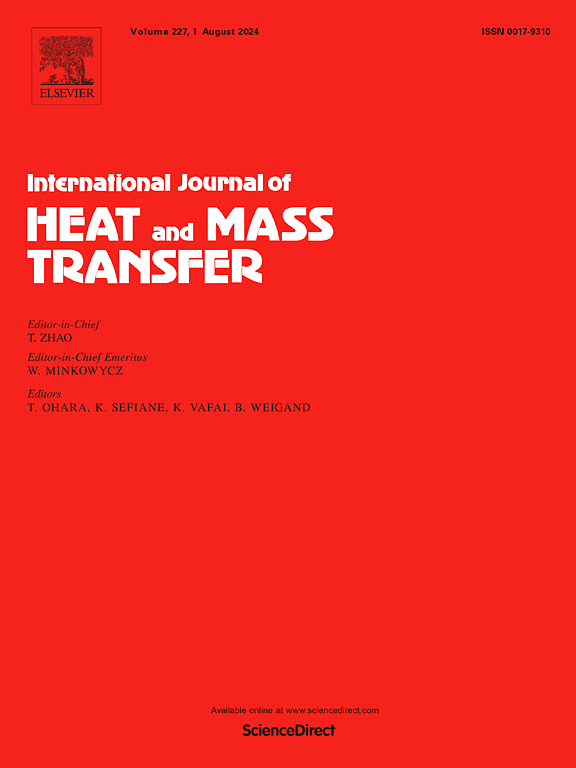斜槽对微型通道散热器中流动沸腾传热和不稳定性影响的实验研究
IF 5
2区 工程技术
Q1 ENGINEERING, MECHANICAL
International Journal of Heat and Mass Transfer
Pub Date : 2024-10-26
DOI:10.1016/j.ijheatmasstransfer.2024.126333
引用次数: 0
摘要
微/微通道与流动沸腾相结合的复合冷却技术在提高传热方面显示出巨大的潜力。然而,要使高热通量设备实现更高效的运行,就必须提高其热传导效率并降低流动沸腾的不稳定性。因此,本研究首先设计了一种底部带有斜槽的微型通道散热器,并在三种质量通量(138.8、230.32 和 331.90 kg/m2-s)和两种入口温度(70 和 80 °C)下对两相流沸腾传热进行了实验研究。微型通道的长度、宽度和高度分别为 200 毫米、2 毫米和 2 毫米。凹槽均匀地排列在微型通道的底部,深度和宽度均为 0.5 毫米,与流动方向的倾斜角为 45°。结果表明,倾斜的凹槽不仅提供了更多的成核点以产生更多的气泡,还阻碍了气泡的过度生长和凝聚,延缓了气泡流向环形流的过渡。此外,与光滑的微型通道散热器相比,带底槽的微型通道散热器能在较低的壁面过热度和较小的有效热通量下实现沸腾,并且成核沸腾的开始时间提前。当入口温度为锡=80 °C,质量通量为 G ≈ 138.81 kg/(m2-s) 时,带底部凹槽的微型水槽在两相区域的最大平均传热系数为 30.70 kW/(m2-K),比光滑微型水槽的传热系数高 18.31 %。此外,底部的倾斜凹槽还能普遍降低压降,产生极佳的净传热强化效果,并缓解流动沸腾的不稳定性。因此,这项研究表明,在微型通道散热器底部设置斜槽可显著提高其整体性能,并为增强两相沸腾传热提供了参考。本文章由计算机程序翻译,如有差异,请以英文原文为准。
Experimental investigation on the effects of inclined grooves on flow boiling heat transfer and instability in a minichannel heat sink
Composite cooling technology combining micro/minichannel and flow boiling has shown great potential in enhancing heat transfer. However, improving their heat transfer efficiency and reducing flow boiling instability is necessary for high heat flux devices to achieve more efficient operation. Therefore, this work first designs a minichannel heat sink with inclined grooves at the bottom and experimentally investigates two-phase flow boiling heat transfer under three mass fluxes (138.8, 230.32, and 331.90 kg/m2·s) and two inlet temperatures (70 and 80 °C). The minichannel with a length, width, and height of 200 mm, 2 mm, and 2 mm, respectively. The grooves are evenly arranged at the bottom of the minichannel, with a depth and width of 0.5 mm and an inclination angle of 45° to the flow direction. Results show that the inclined grooves not only provide more nucleation sites to generate more bubbles but also hinder the excessive growth and coalescence of bubbles, delaying the transition from bubbly flow to annular flow. In addition, compared to the smooth minichannel heat sink, the minichannel heat sink with bottom groove can achieve boiling at lower wall superheat and smaller effective heat flux, and the onset of nucleate boiling is advanced. When the inlet temperature is Tin=80 °C and the mass flux is G ≈ 138.81 kg/(m2·s), the maximum average heat transfer coefficient of the minichannel heat sink with bottom grooves in the two-phase region is 30.70 kW/(m2·K), which is 18.31 % higher than that of the smooth minichannel heat sink. Moreover, the inclined grooves at the bottom generally reduce pressure drop, yield an excellent net effect for heat transfer intensification, and mitigate flow boiling instability. Therefore, this work demonstrates that setting inclined grooves at the bottom of minichannel heat sinks can significantly improve their overall performance and provide a reference for enhancing two-phase boiling heat transfer.
求助全文
通过发布文献求助,成功后即可免费获取论文全文。
去求助
来源期刊
CiteScore
10.30
自引率
13.50%
发文量
1319
审稿时长
41 days
期刊介绍:
International Journal of Heat and Mass Transfer is the vehicle for the exchange of basic ideas in heat and mass transfer between research workers and engineers throughout the world. It focuses on both analytical and experimental research, with an emphasis on contributions which increase the basic understanding of transfer processes and their application to engineering problems.
Topics include:
-New methods of measuring and/or correlating transport-property data
-Energy engineering
-Environmental applications of heat and/or mass transfer

 求助内容:
求助内容: 应助结果提醒方式:
应助结果提醒方式:


